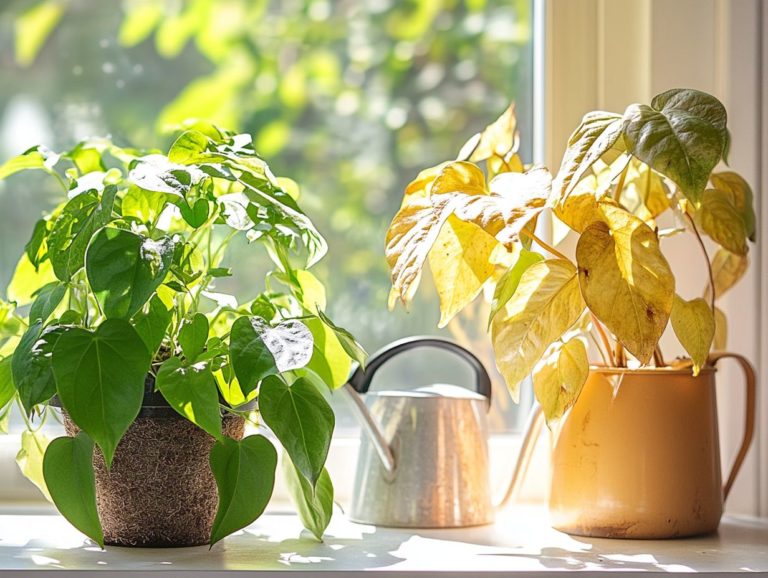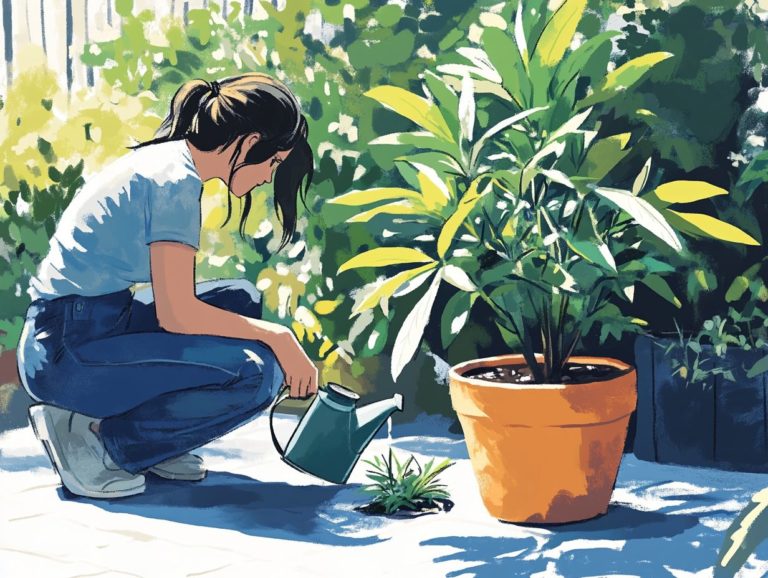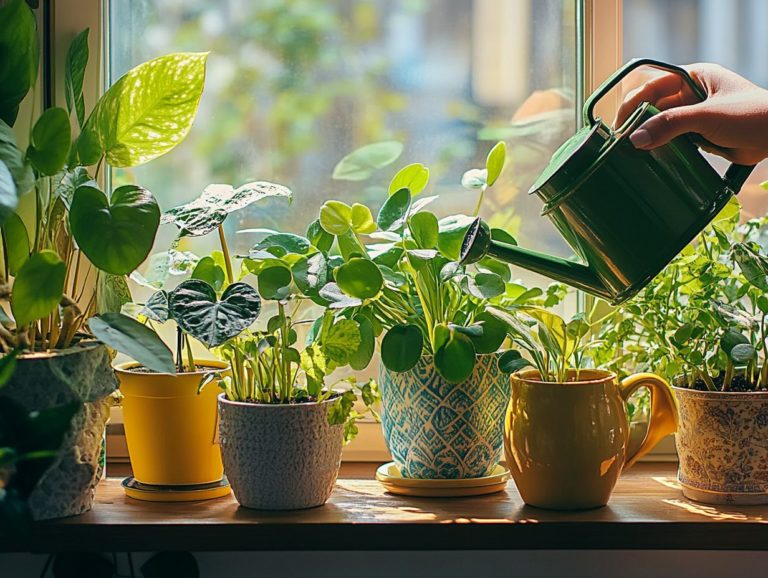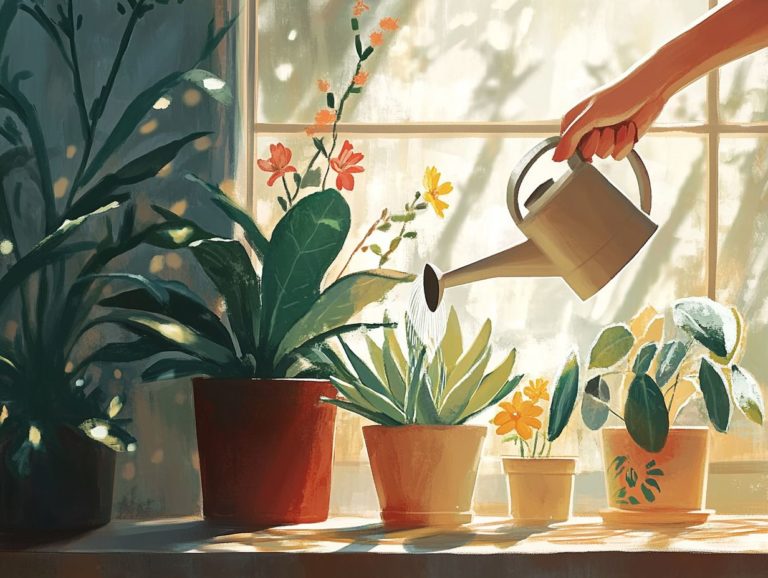5 Techniques to Avoid Overwatering
Watering your plants can be quite the art too little, and they begin to wilt; too much water, and they risk drowning.
Overwatering is one of the most common traps for plant enthusiasts, often leading to root rot and other complications that can endanger your cherished greenery.
This guide will show you five effective techniques to help you water wisely, ensuring your plants not only survive but thrive. From using moisture meters to grouping plants according to their water requirements, you ll discover simple ways to nurture your botanical companions without the peril of overindulgence.
We will also explore the signs of overwatering and provide strategies for reviving affected plants, including how to prevent overwatering. Ready to transform your gardening skills? Let s jump in now!
Contents
- Key Takeaways:
- 1. Use a Moisture Meter
- 2. Water Plants in the Morning
- 3. Check the Soil Before Watering
- 4. Use Mulch to Retain Moisture
- 5. Group Plants with Similar Water Needs Together
- Why Is Overwatering Bad for Plants?
- Frequently Asked Questions
- What are the 5 techniques to avoid overwatering?
- How often should I water my plants to avoid overwatering?
- What is proper drainage and why is it important in avoiding overwatering?
- How does mulching help prevent overwatering?
- What is the purpose of using a rain gauge to avoid overwatering?
- Why is it important to monitor soil moisture when trying to avoid overwatering?
Key Takeaways:

- Use a moisture meter to accurately gauge the watering needs of your plants, helping you avoid underwatering.
- Watering plants in the morning helps them absorb water more efficiently and reduces the risk of overwatering.
- Before watering, check the soil for moisture to avoid overwatering already damp roots.
1. Use a Moisture Meter
Using a moisture meter is one of the most effective ways to ensure your plants receive just the right amount of water. This is crucial in avoiding the all-too-common mistake of overwatering, which can lead to root rot and various other detrimental issues, including mushy growth and yellow leaves.
By accurately assessing the moisture levels in the soil, these handy devices provide valuable insights that can guide your gardening decisions. With the help of technology, moisture meters come in various types think analog and digital models catering to your preferences and budget.
For instance, digital moisture meters offer precise readings with easy-to-read displays, perfect for those who appreciate precision. On the other hand, analog versions offer a straightforward, hands-on approach that some find more appealing. Regardless of the type you choose, both are essential tools that help cultivate optimal plant health by indicating when it s time to water, ultimately promoting stronger roots and lush foliage.
This practice is a game changer for container gardening, where soil can dry out quickly. With a moisture meter in hand, nurturing your plants becomes a more intuitive and effective endeavor.
2. Water Plants in the Morning
Watering your plants in the morning is a simple yet powerful strategy that helps maintain consistent moisture levels while reducing the risk of overwatering. This allows your plants to absorb water before the heat of the day kicks in.
This early watering routine not only provides optimal hydration but also enhances your plants’ overall health. By keeping the foliage dry as the sun rises, you significantly decrease the chances of developing fungal diseases, which thrive in damp, shaded environments.
Watering during the cooler morning hours enables your plants to effectively uptake vital nutrients from the soil, boosting their growth and vitality. Such a practice fosters a thriving garden ecosystem, ultimately resulting in robust foliage and vibrant blooms that can withstand various environmental stresses.
3. Check the Soil Before Watering
Before you water your plants, take a moment to check the soil s moisture level. This simple step can help you avoid the detrimental effects of overwatering, ensuring that your plants stay healthy and vibrant.
It’s equally important to recognize the signs of excess moisture. If you notice yellowing leaves and mushy growth, it s a clear indication that the soil has been too saturated for too long. Using a moisture meter can offer precise measurements, providing you with the confidence that you’re giving your plants the care they deserve and helping to keep the soil moisture just right. Pairing this tool with the tactile experience of feeling the soil can elevate your gardening routine, helping you better understand each plant s specific needs.
By promptly responding to these indicators, you can prevent root rot and other water-related issues, ultimately nurturing a flourishing green space.
4. Use Mulch to Retain Moisture
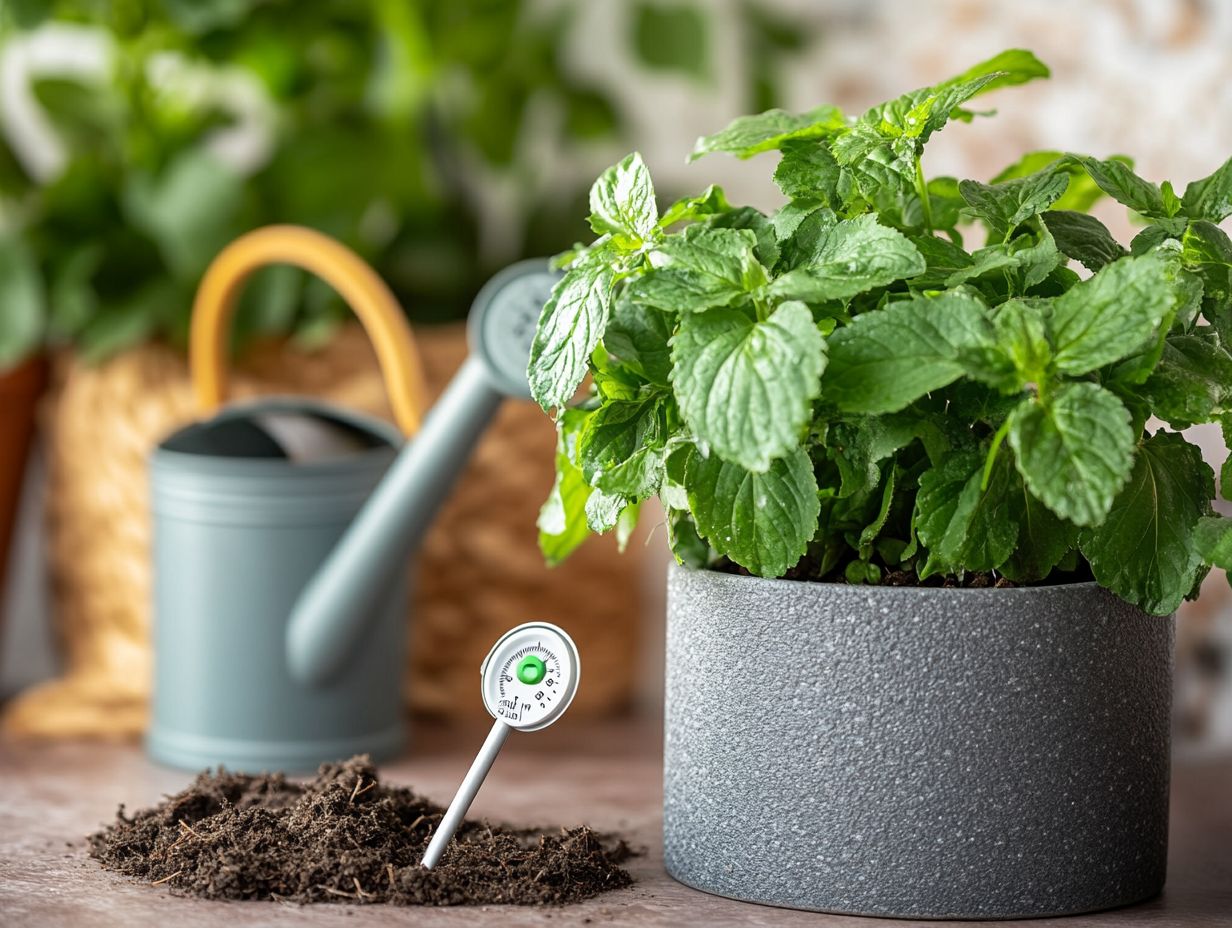
Applying mulch around your plants is an effective strategy for retaining moisture in the soil and minimizing evaporation. It fosters healthier growth while also guarding against the negative impacts of overwatering.
In container gardening, you will find various types of mulch like wood chips, straw, and shredded leaves each with unique advantages. These materials boost moisture retention and form a barrier against pesky weeds that compete for vital nutrients and water, allowing your plants to thrive.
As organic mulches decompose, they enrich the soil with essential nutrients. When selected thoughtfully, mulch enhances air circulation around the roots, vital for preventing issues like root rot, which is when roots decay due to excess water. Consistent moisture levels and good airflow promote robust plant health, allowing your container gardens to truly thrive.
5. Group Plants with Similar Water Needs Together
Grouping plants with similar water needs is a smart strategy that simplifies your watering routine. This helps you avoid the dreaded overwatering dilemma, resulting in happier, healthier plants.
By familiarizing yourself with the specific water requirements of different plant types—think succulents, cacti, and houseplants like aloe vera—you will master your garden watering in no time! This thoughtful organization reduces risks associated with improper hydration, like root suffocation and nutrient deficiencies. Additionally, exploring 5 unique watering techniques for exotic plants can further enhance your plant care skills.
When you group similar plants together, you create not just a thriving ecosystem, but also enhance the overall beauty of your garden. Each plant receives the hydration it needs to flourish, contributing to a more vibrant, resilient environment.
Why Is Overwatering Bad for Plants?
Overwatering can be detrimental as it robs roots of essential oxygen, leading to root rot and making the soil waterlogged. This occurs when roots become waterlogged and vulnerable to fungal pathogens, significantly compromising plant health.
Overwatering also disrupts the nutrient balance in the soil. When plants are overwhelmed with excess water, crucial nutrients can leach away, making them less accessible for uptake. This imbalance may show up as yellowing leaves and stunted growth clear signs that something is wrong.
Watch for early signs of overwatering. If your plants wilt even though the soil is wet or if you smell a musty odor, it’s time to act! By addressing these symptoms quickly, you can adjust your watering habits and improve drainage. To learn more about preventing overwatering, check out this guide on how to avoid overwatering indoor plants. This ensures your plants receive the oxygen and nutrients they need for robust health and vibrant growth.
How Can Overwatering Affect Different Types of Plants?
Different plants respond uniquely to overwatering. For instance, succulents and cacti, which thrive in dry conditions, are particularly vulnerable to root rot when drenched. Houseplants like aloe vera may display yellow leaves as a distress signal.
Tropical plants such as ferns can wilt and develop brown tips when the soil is too saturated. Flowering plants like begonias might show signs of fungal growth if they live in excessive moisture. Understanding each species’ specific water needs is beneficial for their health and plays a crucial role in managing pests naturally.
By keeping a close eye on water levels, you can prevent stress that often attracts pests. This fosters a flourishing ecosystem for your plants while minimizing the need for chemical interventions and ensuring good hydration practices.
What Are the Signs of Overwatering in Plants?
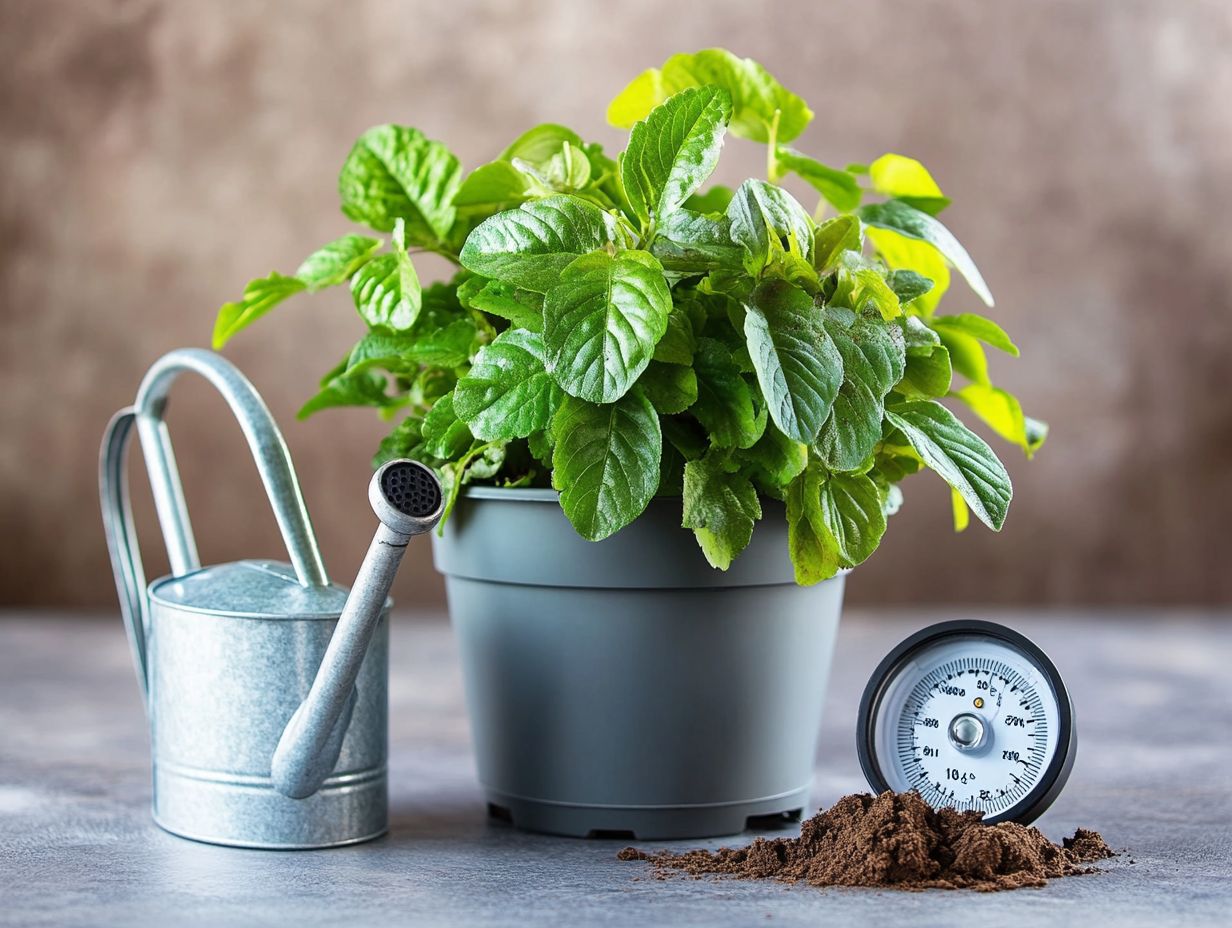
Recognizing the signs of overwatering is essential for maintaining the health of your plants. Look out for common indicators such as yellow leaves, mushy growth, a musty smell rising from the soil, and droplets of moisture clinging to the leaves.
These symptoms often suggest that the roots may be struggling, unable to absorb the oxygen and nutrients they need. This can lead to complications such as root rot (a condition where roots decay due to excess moisture). Yellow leaves typically signal stress, while mushy growth points to rot. A musty odor frequently indicates fungal issues lurking beneath the surface, and those moisture droplets are a sure sign of inadequate air circulation.
To combat overwatering, it’s crucial to reassess your watering schedule. Ensure that the top inch of soil dries out between waterings and check for signs of excess water. Improving drainage by choosing pots with holes or incorporating perlite (a lightweight material that helps with drainage) into the soil can make a significant difference. For those gardening in challenging conditions, following 5 tips for watering in dry climates can be particularly beneficial. In cases of severe root rot, you may need to repot the plant in dry soil to help restore its health.
How Can One Determine the Water Needs of Their Plants?
To accurately assess the water needs of your plants, using a tool that measures soil wetness offers precise readings. Complement this with physical checks to gauge soil moisture levels. This duo will guide you in honing your watering practices effectively and ensuring your plants receive what they need to flourish.
Keeping an eye on the foliage and the overall health of your plants can provide vital clues about their hydration status. For instance, if you notice droopy leaves, it might be time to increase the moisture. Conversely, yellowing leaves can be a telltale sign of overwatering.
By blending these techniques, you can cultivate a thorough understanding of when to water. This optimizes the health and growth of your plants. Utilizing 5 tips for watering low-light plants ensures this well-informed approach not only fosters vibrant greenery but also saves you time and resources, ensuring you skillfully sidestep both overwatering and underwatering mishaps, making your plants happier as a result.
What Are Some Common Mistakes That Lead to Overwatering?
Common mistakes that can lead to overwatering include not allowing the soil to dry out between waterings, using decorative pots lacking adequate drainage, and neglecting to adjust your watering routine with the changing seasons.
These oversights can significantly impact the health of your plants. When roots become waterlogged and suffocated, you risk inviting root rot and other harmful issues. Excess water in the soil deprives roots of essential oxygen, weakening the plant and potentially leading to stunted growth or even death, which results in mushy growth.
To prevent these pitfalls, it’s vital to establish a watering schedule tailored to each plant’s specific water needs. Opting for pots with drainage holes will allow excess water to escape. Regularly checking the moisture level with your finger or a moisture meter will help you determine the right time to water. Additionally, being aware of common watering mistakes to avoid can enhance your gardening skills. By adjusting these practices with the seasons, you can create a flourishing environment where your plants can truly thrive.
How Can One Revive an Overwatered Plant?
It s time to revive your plants! Reviving an overwatered plant is entirely within your reach. Start by gently removing it from its pot and inspecting the roots for any signs of root rot. Allow the excess water to drain off while enhancing air circulation around those roots.
Once you ve carefully assessed the root system, it s crucial to trim away any blackened or mushy roots those are your telltale signs of decay. After identifying the healthy roots, consider replanting your green friend into fresh, well-draining potting compost. This choice will provide the vital aeration needed to prevent future issues. Ensure that the new pot features drainage holes to keep excess water from accumulating.
Moving forward, adjusting your watering practices is essential. Allow the soil to dry out between waterings, and keep a close eye on the plant’s moisture needs based on its environment. This proactive approach will help you maintain the plant’s health and prevent similar troubles in the future, helping to prevent overwatering and avoid underwatering.
Frequently Asked Questions
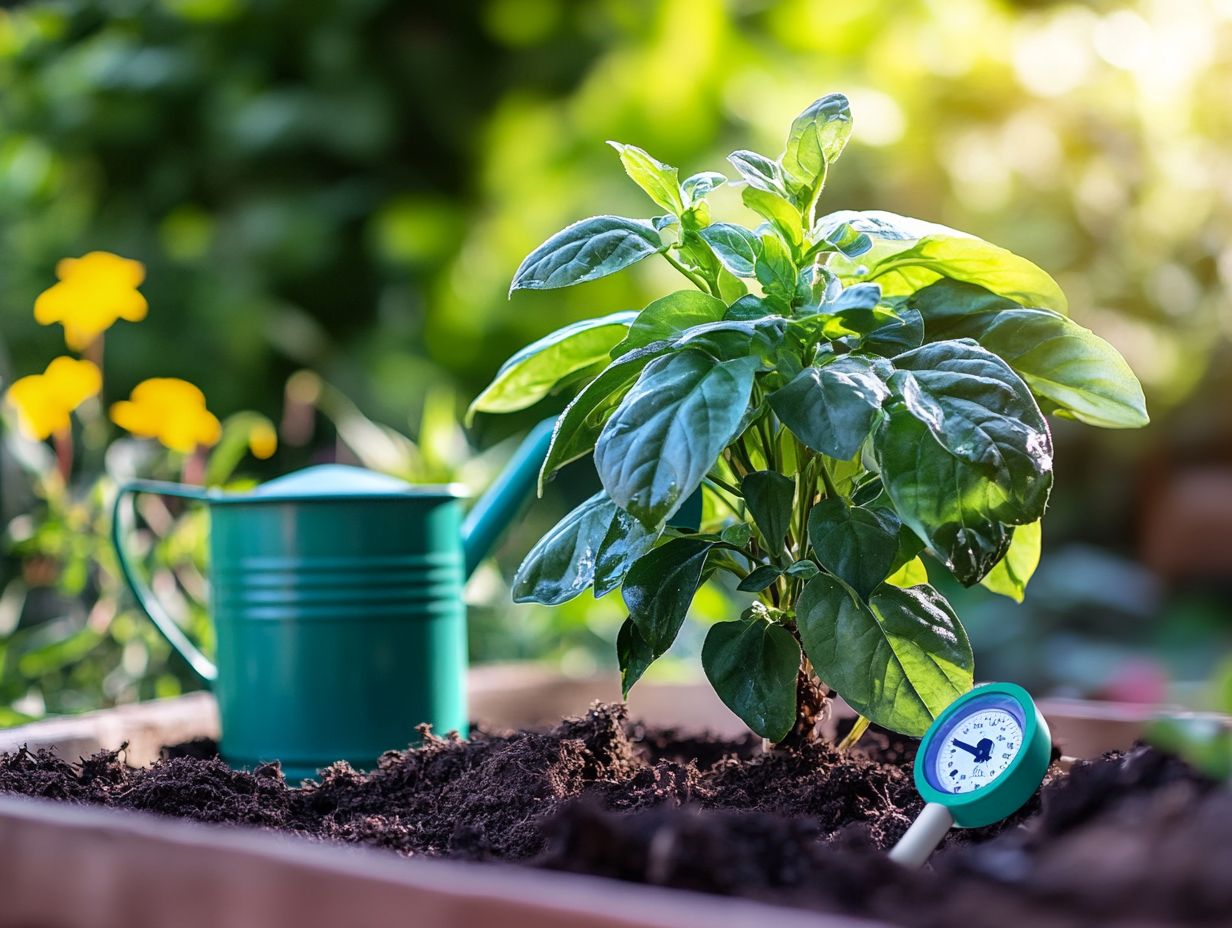
What are the 5 techniques to avoid overwatering?
The 5 techniques to avoid overwatering are: a proper watering schedule, good drainage, mulching, using a rain gauge, and monitoring soil moisture.
How often should I water my plants to avoid overwatering?
The frequency of watering depends on the type of plant and its specific needs. It’s important not to water too frequently to prevent overwatering.
What is proper drainage and why is it important in avoiding overwatering?
Proper drainage means having enough holes at the bottom of your plant’s pot. This allows excess water to drain out, preventing water from accumulating and causing root rot.
How does mulching help prevent overwatering?
Mulching is a fantastic way to keep your soil moist and happy! It covers the soil with materials like leaves or wood chips to help retain moisture and reduce the need for frequent watering.
What is the purpose of using a rain gauge to avoid overwatering?
A rain gauge is a helpful tool for measuring how much natural rainfall your plants receive. This helps you adjust your watering schedule and avoid overwatering.
Why is it important to monitor soil moisture when trying to avoid overwatering?
Monitoring soil moisture is crucial for preventing overwatering. It allows you to check if the soil is already moist enough before watering again.
It also helps identify potential issues, such as poor drainage or watering too frequently.
Do you want to ensure your plants get just the right amount of water? Let’s dive into how you can avoid overwatering! Start implementing these techniques today to keep your plants thriving!


